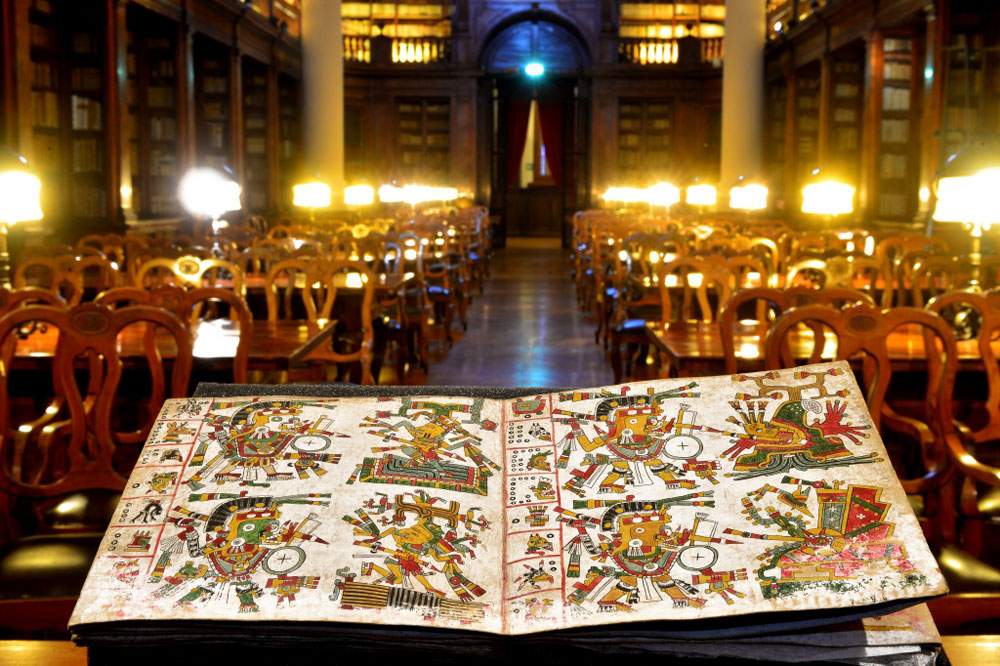A very rare pre-Columbian manuscript, known as the Cospi Codex, is kept at the University Library of Bologna and these days is the focus of a campaign of analysis, carried out in collaboration with the Palazzo Poggi Museum of the University Museum System. Through advanced non-invasive techniques, a team of scholars will attempt to reconstruct the composition of the brilliant colors with which the ancient volume was painted in the late 15th and early 16th centuries.
Carried out through the MOLAB platform, the new analysis campaign is made possible thanks to a Carisbo Foundation grant (Art and Culture call) awarded to the Department of History Cultures Civilizations of the University of Bologna.
“Advanced hyperspectral and fluorescence imaging techniques will be employed to map the distribution of the materials used, both organic and inorganic, throughout the pages of the codex,” explained Davide Domenici, University of Bologna professor and coordinator of the initiative. “This will allow us to investigate in a hitherto unthinkable detail the technological and pictorial practices developed by pre-Columbian artists.”
The Aztec manuscript is one of the very rare pre-Columbian books (there are a dozen in all) that have survived the ravages of time and the destructive action of conquerors and evangelizers. The codex thus bears witness to an immense book heritage often condemned to oblivion: it was probably brought to Bologna by the Spanish Dominican Domingo de Betanzos on the occasion of his meeting with Pope Clement VII on March 3, 1533. Since then the precious manuscript has remained in Bologna, passing first in the collection of Ferdinando Cospi and later in that of the Institute of the Academy of Sciences, until it reached the University Library of Bologna, where it is still preserved today.
A first campaign of non-invasive analysis was carried out in 2006. From the latter , the first of its kind in the world for a pre-Columbian manuscript, the researchers involved (Davide Domenici, Antonio Sgamellotti, Costanza Miliani) began to analyze most of the pre-Columbian manuscripts that exist today, kept in institutions, such as the Museo de América in Madrid, the British Museum, the World Museum in Liverpool, the Bodleian Library in Oxford and the Vatican Library. Now, after fifteen years, technological advances have made new survey techniques available to scholars, thanks to which it will be possible to learn more about Aztec writing and drawing techniques.
The new analysis campaign is being conducted through the MOLAB platform of E-RIHS.it and involves a team of researchers from the SMAArt (Scientific Methodologies applied to Archaeology and Art) Center of Excellence at the University of Perugia, the CNR’s “Giulio Natta” Institute of Chemical Sciences and Technologies (SCITEC-CNR) and the CNR’s Institute of Cultural Heritage Sciences (ISPC-CNR), under the coordination of Laura Cartechini (SCITEC-CNR) and Aldo Romani (SMAArt).
Analyses on the Cospi Codex will be carried out using a Macro-XRF scanner: an instrument that, thanks to X-rays, makes it possible to investigate the elemental composition of the object in question. From the distribution of chemical elements, it will be possible to identify the pigments that contain them. For example, the distribution of orpiment, a yellow pigment of mineral origin, will be able to be reconstructed from the presence of arsenic, the element of which it is composed.
The manuscript will also be subjected to the hyperspectral chamber in the visible-a method of analysis that allows us to understand how visible light is absorbed, reflected and emitted. Because these properties may be specific to certain compounds, through the hyperspectral chamber it is possible to map their distribution. In particular, it will be possible, for example, to map the use of organic dyes, such as indigo, which was used, along with specific clays, in the production of the famous Mayan Blue.
 |
| Bologna, investigation campaign launched on a rare pre-Columbian manuscript |
Warning: the translation into English of the original Italian article was created using automatic tools. We undertake to review all articles, but we do not guarantee the total absence of inaccuracies in the translation due to the program. You can find the original by clicking on the ITA button. If you find any mistake,please contact us.